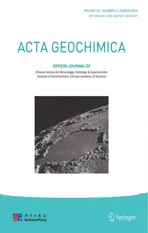The Taylor Moon
2016-03-18WeidongSun
Wei-dong Sun
COMMENTARY
The Taylor Moon
Wei-dong Sun1,2
DOI 10.1007/s11631-015-0083-1
The formation of the Moon remains obscure after~400 years since Galileo saw that the Moon was mountainous in 1609.The current hypothesis is that the Moon formed through a low-angle collision between the Earth and Mar-size impactor,which isknown asthe GiantImpactmodel(e.g.Benz etal.1989).The giantimpactshould be sufficiently energetic to vaporize much of the material that went to make up the Moon.This explains the depletion ofvolatile elements in the Moon.According to this scenario,the Moon should contain a significant amount of material from the impactor. This is now challenged by geochemists(e.g.Stevenson and Halliday 2014;Asphaug 2014).As pointed outby Taylor,itis very likely thatthe possible Moon-forming impactorspossess isotopic ratios that differ from those of Earth(Taylor 2016). Isotopic analysis of lunar samples,however,has revealed little trace of material other than that resembling the Earth,i.e.,the isotope ratios for the non-volatile elements in the Moon have nearly identical values to those on the Earth.
In this volume,Taylor proposed two alternative models. The first model is that the Moon may have been formed through a process similar to the formation of tektites,which excavates part of the terrestrial mantle(low in metallic iron),depletes the proto-lunar material in volatiles, melts much of the material and left little or no trace of itself(Taylor 2016).This model,however,still needs to explain why the impactor was not seen in the Moon.
Another model is Cometary Impact about 100 Ma after the formation of the Earth.Given that the composition of the Moon looks like massive distal ejecta from the terrestrial mantle without definitive evidence of the impacting body,it is proposed that massive impacts on the terrestrial mantle by icy comets,which provided energy to melt most of the Moon,deplete the volatile elements,and leave little or any trace of the impactor(Taylor 2016).
The Earth is a rocky planet,which requires additional water possibly from icy comets(Albarede 2009).This stimulating model explains both the formation of the Moon and the possession of water in the Earth.
The challenges of this model are:first,Hf-W isotopes suggest that the Moon-forming Impact occurred at~30 Ma after the formation of the Earth(Yin et al.2002),whereas it has been proposed that the addition of water occurred 70 Ma later(Albarede 2009).Moreover,it may also needs additional mechanism to explain the dry nature of the Moon.
This comment refers to the article available at doi:10.1007/s11631-015-0080-4.
Albarede F(2009)Volatile accretion history of the terrestrial planets and dynamic implications.Nature 461:1227-1233.doi:10.1038/ nature08477
Asphaug E(2014)Impact origin of the Moon.Ann Rev Earth Planet Sci 42:551-578
Benz W,Caneron AGW,Melosh HJ(1989)The origin of the Moon and the single impact hypothesis.Icarus 81:113-131
Stevenson DJ,Halliday AN(2014)Origin of the Moon.Phil Trans A Roy Soc London 372:20140289
Taylor SR(2016)The Moon.Acta Geochim
Yin QZ et al(2002)A short timescale for terrestrial planet formation from Hf-W chronometry of meteorites.Nature 418:949-952
Published online:27 November 2015
©Science Press,Institute of Geochemistry,CAS and Springer-Verlag Berlin Heidelberg 2015
✉Wei-dong Sun weidongsun@gig.ac.cn
1CAS Key Laboratory of Mineralogy and Metallogeny,Guangzhou Institute of Geochemistry,Chinese Academy of Sciences,Guangzhou 510640,China
2CAS Center for Excellence in Tibetan Plateau Earth Sciences,Chinese Academy of Sciences,Beijing 100101,China
